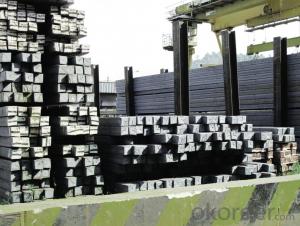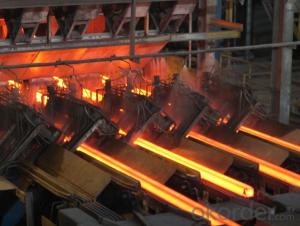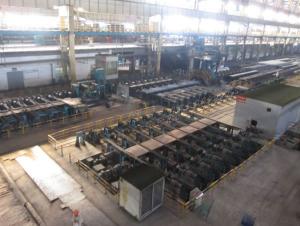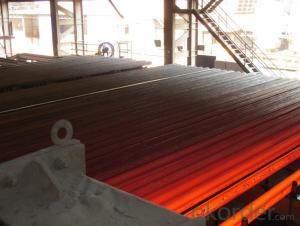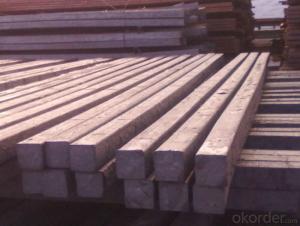Prime square alloy steel billet 100mm Q235
- Loading Port:
- Shanghai
- Payment Terms:
- TT OR LC
- Min Order Qty:
- 100 m.t.
- Supply Capability:
- 10000 m.t./month
OKorder Service Pledge
OKorder Financial Service
You Might Also Like
Structure of Prime square alloy steel billet 100mm Q235

Description of Prime square alloy steel billet 100mm Q235
1) Excellent corrosion resistance: The zinc layer provides a good protection of Pre-painted Galvanizeed Steel Sheet.
2) High heat resistance: The reflective surface of the material aids in efficiently reflecting the sunlight away and in turn reducing the amount of heat transmitted. The thermal reflectivity converts into energy savings.
3) Aesthetics: Pre-Painted Galvanized steel sheet is available in plethora of patterns and multiple sizes as per the requirements that given by our customers.
4) Versatility: can be used in the various areas.

Main Feature of Prime square alloy steel billet 100mm Q235
Uncoated CR steel sheet
With the features of in line with the international highest standards in demension and shape, excellent surface finish and properties, the products are mainly used in home appliance and automobile industries.
Galvanized steel sheet(include HDG and EG)
With the features of good corrosion resistance, the products are mainly used in automobile, home appliance, electronics, building and machinery manufacture industries, etc.
Precoated steel sheet
With the features of enviromental protection and good processablility, long lasting surface durability, rich in colors, the products are maily used in building, home appliance and furniture industries, etc.
Applications of Prime square alloy steel billet 100mm Q235
1) Excellent corrosion resistance: The zinc layer provides a good protection of Pre-painted Galvanizeed Steel Sheet.
2) High heat resistance: The reflective surface of the material aids in efficiently reflecting the sunlight away and in turn reducing the amount of heat transmitted. The thermal reflectivity converts into energy savings.
3) Aesthetics: Pre-Painted Galvanized steel sheet is available in plethora of patterns and multiple sizes as per the requirements that given by our customers.
4) Versatility: can be used in the various areas.

Specifications of Prime square alloy steel billet 100mm Q235
Product | Billet |
Material Grade | SGCC / SGCH / DX51D+AZ, etc |
Thickness | 0.6-3.0mm |
Width | 500-1500mm |
Tolerance | Thickness: +/-0.02mm , Width:+/-2mm |
Zinc-coating | Z30-150g/m2 |
Technique | Raw material: Hot rolled steel coil --> Cold rolled_>hot dipped galvalume |
Surface | Dried, Chromated, Unoiled |
Spangle | Regular spangle , small spangle, zero spangle |
ID | 508MM 610MM |
Coil weight | 1-25MT |
Export package | Cardboard inner sleeves, Waterproof paper, galvanized steel covered and steel strip packed |
FAQ of Prime square alloy steel billet 100mm Q235
We have organized several common questions for our clients,may help you sincerely:
1. How Can I Visit There?
Our company is located in Tianjin City, China, near Beijing. You can fly to Tianjin Airport Directly. All our clients, from home or aboard, are warmly welcome to visit us!
2. How Can I Get Some Sample?
We are honored to offer you sample.
3. Why choose CNBM?
we always fix steel produce in container well to make it safe arrive at destination port
we always provide best and professional forward service for our buyer
we always apply 14days free detention for our buyers container in destination
we provide one set After-sales service for our buyer
we provide China inland steel market price report
we help our buyer become number one in local market .
- Q:How do steel billets differ from steel bars?
- Steel billets and steel bars, two intermediate steel products utilized in various industries for further processing, exhibit distinct differences. 1. Shape: Steel billets typically assume square or rectangular shapes, with cross-sectional dimensions ranging from a few inches to several feet. They are typically manufactured through continuous casting or hot rolling procedures. Conversely, steel bars adopt cylindrical shapes and maintain a uniform diameter throughout their length. They are usually produced through hot rolling or cold drawing processes. 2. Size: Steel billets tend to be larger compared to steel bars. Billets can measure from a few feet to several meters in length, while their cross-sectional dimensions can be customized based on the final product's requirements. Conversely, steel bars are typically manufactured in standardized sizes and lengths, such as 6 meters or 12 meters, and possess consistent diameters. 3. Production process: Steel billets are commonly generated through continuous casting or hot rolling methods. Continuous casting involves pouring molten steel into a mold, resulting in a solid billet. Hot rolling, on the other hand, entails passing the billet through multiple rollers to reduce its cross-sectional dimensions. In contrast, steel bars are produced through hot rolling or cold drawing processes. Hot rolling involves guiding billets through a series of rollers to achieve the desired shape and size, while cold drawing requires pulling the hot rolled bars through a die to further reduce their diameter and enhance their surface finish. 4. Applications: Steel billets primarily serve as raw materials for subsequent processing into various steel products, such as bars, rods, wires, and tubes. Additionally, they find application in the forging industry for the production of forged components. Steel bars, in contrast, enjoy a wide range of applications in construction, manufacturing, infrastructure, and automotive industries. They are commonly employed as reinforcement in concrete structures and in the production of shafts, gears, axles, and other machine parts. To summarize, steel billets and steel bars differ in terms of shape, size, production process, and applications. Billets, with their larger size and square or rectangular shape, serve as raw materials for further processing. Meanwhile, bars, with their cylindrical form and consistent diameter, find application in various industries for specific purposes.
- Q:How are steel billets used in the manufacturing of defense equipment?
- Steel billets are used in the manufacturing of defense equipment as they serve as the raw material for forging various components and parts. These billets are heated, shaped, and machined to create the necessary structures, such as gun barrels, armor plates, and gears, which are crucial for the production of durable and reliable defense equipment.
- Q:What are the different types of steel billet surface defects?
- There are several different types of steel billet surface defects that can occur during the manufacturing process. These defects can affect the quality and performance of the steel, and it is important to identify and address them to ensure the integrity of the final product. 1. Scale: Scale is a common defect that occurs as a result of oxidation during the heating and rolling process. It appears as a thin layer of iron oxide on the surface of the billet and can be easily removed through descaling processes. 2. Cracks: Cracks are another common defect that can occur on the surface of steel billets. They can be caused by several factors such as uneven cooling, excessive stress, or improper handling. Cracks can lead to weakened structural integrity and should be repaired or the affected billets discarded. 3. Pitting: Pitting is a defect characterized by small, shallow depressions or pits on the surface of the billet. It can be caused by a variety of factors including impurities in the steel, improper cooling, or corrosion. Pitting can lead to reduced strength and increased susceptibility to corrosion. 4. Lamination: Lamination defects occur when there are layers or separation within the billet caused by poor bonding during the manufacturing process. This defect can compromise the mechanical properties of the steel and may result in failure under stress. 5. Inclusions: Inclusions are non-metallic substances that become trapped within the billet during the manufacturing process. They can include slag, oxides, or other impurities. Inclusions can weaken the steel and reduce its ductility, making it more prone to cracking or breaking. 6. Scratches: Scratches are superficial defects that can occur during handling or transportation of the billets. While they may not greatly affect the overall structural integrity of the steel, they can lead to localized stress concentrations and potential failure in certain applications. 7. Decarburization: Decarburization is a defect that occurs when the surface of the billet loses its carbon content during the heating process. This can lead to reduced hardness and strength in the affected area, affecting the performance of the steel. It is important for manufacturers and inspectors to be aware of these different types of steel billet surface defects to ensure the production of high-quality steel products. Regular inspections, quality control measures, and appropriate corrective actions can help minimize and address these defects to ensure the desired performance and longevity of the steel.
- Q:How are steel billets used in the production of pump parts?
- Steel billets are an essential component in the production of pump parts. These billets, which are semi-finished metal forms, serve as the starting material for manufacturing various pump components. Firstly, steel billets are heated and then molded into the required shape using a range of techniques such as forging, casting, or extrusion. This process ensures that the billets are transformed into the desired pump part, such as impellers, casings, or shafts. Once the billets have been shaped, they undergo further machining processes, such as milling, drilling, and turning, to achieve the precise dimensions and specifications needed for pump parts. These machining operations ensure that the billets are transformed into functional components that can effectively perform their intended tasks within the pump system. Moreover, steel billets provide the necessary strength and durability required for pump parts to withstand the demanding conditions and pressures associated with pumping operations. The high tensile strength and resistance to corrosion of steel make it an ideal material choice for pump components, ensuring their longevity and reliability. In addition, steel billets can be further treated or coated to enhance their performance characteristics. For instance, they can undergo heat treatment processes such as annealing, quenching, or tempering to achieve specific mechanical properties, such as improved hardness or increased resistance to wear and tear. Coatings, such as galvanizing or electroplating, can also be applied to steel billets to enhance their corrosion resistance. Overall, steel billets play a crucial role in the production of pump parts by providing a versatile and robust starting material that can be shaped, machined, and treated to meet the specific requirements of different pump systems. By utilizing steel billets, pump manufacturers can produce high-quality pump parts that ensure efficient and reliable pumping operations across various industries.
- Q:What are the main alloying elements used in steel billet production?
- The main alloying elements used in steel billet production are carbon, manganese, silicon, and chromium. Carbon is the most important alloying element, as it enhances the strength and hardness of the steel. Manganese is added to improve the toughness and hardenability of the steel. Silicon is added to enhance the steel's resistance to corrosion and oxidation. Chromium is used to increase the steel's hardness, corrosion resistance, and wear resistance. These alloying elements are carefully controlled and added to steel during the production process to achieve the desired properties and characteristics in the final steel billets.
- Q:What is the average lifespan of a steel billet in the automotive industry?
- The average lifespan of a steel billet in the automotive industry can vary depending on several factors such as the specific application, type of steel used, and maintenance practices. However, on average, steel billets in the automotive industry can last for several years to decades, especially when properly cared for and maintained.
- Q:How often is it? What is the range of temperature in the process of rolling? What is the temperature of the final rolling?
- The final rolling temperature is the rolling temperature of the last pass, and also the rolling temperature of the rolling pass at the last effective (very small level pass, not an effective rolling pass)
- Q:How do steel billets contribute to the overall cost-effectiveness of a structure?
- Steel billets play a crucial role in enhancing the overall cost-effectiveness of a structure in multiple ways. Firstly, steel billets are manufactured through a highly efficient process that ensures minimal wastage of raw materials. This efficiency significantly reduces the production cost of steel billets, making them a cost-effective choice for construction projects. Moreover, steel billets possess exceptional strength and durability, enabling them to withstand heavy loads and adverse weather conditions. This strength eliminates the need for frequent repairs or replacements, saving significant costs in the long run. Additionally, the durability of steel billets ensures the longevity of the structure, reducing maintenance expenses and enhancing cost-effectiveness. Another significant contribution of steel billets to cost-effectiveness lies in their versatility. Steel billets can be easily molded and shaped into various forms, allowing for customization and precise engineering in constructing the structure. This versatility eliminates the need for excessive material wastage and enables the optimization of resources, thereby reducing costs. Furthermore, steel billets have excellent fire resistance properties, making them a safe and reliable choice for structures. By minimizing the risk of fire-related damages, steel billets contribute to reduced insurance costs for the structure, enhancing its overall cost-effectiveness. Lastly, steel billets are often produced using recycled steel, which not only reduces the environmental impact but also lowers the production cost. This eco-friendly aspect further enhances the cost-effectiveness of a structure by reducing the overall carbon footprint and making it more sustainable in the long term. In conclusion, steel billets contribute to the overall cost-effectiveness of a structure by minimizing material wastage, providing strength and durability, offering versatility in design and engineering, ensuring fire resistance, and promoting sustainability. These factors collectively reduce production, maintenance, repair, and insurance costs, making steel billets an economically beneficial choice for construction projects.
- Q:What are the different methods of steel billet surface inspection?
- In the industry, various methods are commonly employed for inspecting the surface of steel billets. These techniques aim to identify any flaws or imperfections, guaranteeing the use of high-quality steel in the manufacturing process. 1. Visual inspection: Trained inspectors visually examine the billet's surface for visible defects like cracks, dents, scratches, or irregularities. While a straightforward approach, it serves as a crucial initial step in the inspection process. 2. Magnetic particle inspection: This method involves applying a magnetic field to the billet's surface and then introducing iron particles suspended in liquid. If there are any surface defects or cracks, the iron particles adhere to them, creating a visible indication. This technique is especially effective for detecting surface cracks. 3. Eddy current testing: Employing electromagnetic induction, this method detects surface defects. A probe is passed over the billet's surface, and any changes in electrical conductivity caused by cracks or defects generate eddy currents, which can be identified and analyzed. It is commonly used for detecting surface cracks, but it can also measure coating thickness or identify material property variations. 4. Ultrasonic testing: Ultrasonic waves are utilized to inspect the billet's surface for defects. A transducer sends ultrasonic waves into the material, and any changes in the wave pattern caused by surface defects are detected and analyzed. This method is frequently employed for detecting surface cracks, but it also provides insight into the internal structure of the billet. 5. Dye penetrant inspection: This method involves applying colored dye to the billet's surface, which is then removed, leaving the dye trapped within any defects or cracks. A developer is then applied to enhance the visibility of the dye, facilitating the identification and localization of surface defects. It is particularly effective for detecting small surface cracks. 6. Laser scanning: Laser scanning employs a laser beam to scan the billet's surface and generate a three-dimensional representation. This method is valuable for detecting surface irregularities, measuring dimensions, and creating digital models for further analysis. Each of these methods possesses unique advantages and limitations, often employed in combination to ensure a comprehensive inspection of the steel billet's surface. The choice of inspection method depends on factors such as the targeted defects, billet size and shape, and desired level of accuracy.
- Q:Are steel billets used in the production of household appliances?
- No, steel billets are typically not used in the production of household appliances.
1. Manufacturer Overview |
|
|---|---|
| Location | |
| Year Established | |
| Annual Output Value | |
| Main Markets | |
| Company Certifications | |
2. Manufacturer Certificates |
|
|---|---|
| a) Certification Name | |
| Range | |
| Reference | |
| Validity Period | |
3. Manufacturer Capability |
|
|---|---|
| a)Trade Capacity | |
| Nearest Port | |
| Export Percentage | |
| No.of Employees in Trade Department | |
| Language Spoken: | |
| b)Factory Information | |
| Factory Size: | |
| No. of Production Lines | |
| Contract Manufacturing | |
| Product Price Range | |
Send your message to us
Prime square alloy steel billet 100mm Q235
- Loading Port:
- Shanghai
- Payment Terms:
- TT OR LC
- Min Order Qty:
- 100 m.t.
- Supply Capability:
- 10000 m.t./month
OKorder Service Pledge
OKorder Financial Service
Similar products
New products
Hot products
Related keywords
